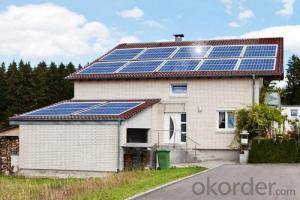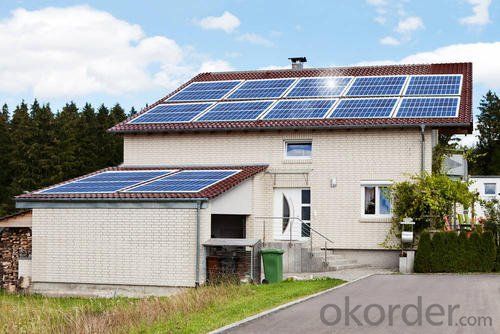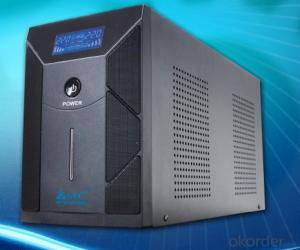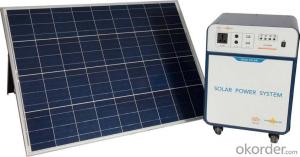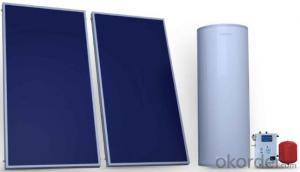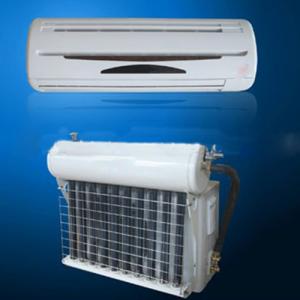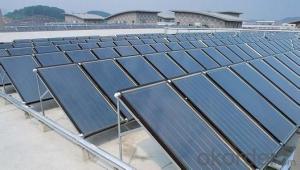Solid Solar Energy Split-Type Home Energy Storage System
- Loading Port:
- Shanghai
- Payment Terms:
- TT OR LC
- Min Order Qty:
- 1 set
- Supply Capability:
- 500 set/month
OKorder Service Pledge
OKorder Financial Service
You Might Also Like
Specification
1. Descriptions of Split-type Solar Home Energy Storage System
- Split-type solar home energy storage system is a collection of lithium-ion battery packs, intelligent controllers and output control of household energy storage control system,Has the advantages of high energy density, long cycle life, good temperature characteristics, excellent safety performance
- Output panel can read the battery capacity and voltage at any time, a key control is simple and convenient, double protection and application of high security, Three sets of voltage stable output, suitable for a variety of low-voltage electrical appliances, low-voltage output more secure, compact and easy to install
2. Component of the split-type solar home energy storage system
- Solar panels spring
-Split-type home energy storage system
-Output control panel
3. Technical Parameter Split-type Solar Home Energy Storage System
| Model | LVSS-FJY03600 | LVSS-FJY07200 | LVSS-FJY12000 | LVSS-FJY16800 | LVSS-FJY24000 | |
| Load | Power | 15W | 30W | 50W | 70W | 100W |
| Description | Light bulb/ Fan/ DVD | Light bulb+Fan/ Light bulb+DVD/ Light bulb+DVD | TV set Set-top boxes | TV set+Set-top boxes Light bulb+Fan/ Light bulb+DVD/ Light bulb+DVD | TV set +Set-top boxes +light bulb +Car refrigerator | |
| Solar panel | Power | 90Wp | 180Wp | 300Wp | 450Wp | 640Wp |
| Lithium battery system | Capacity | 360Wh | 720Wh | 1200Wh | 1680Wh | 2400Wh |
| Continuous working time | 24H | |||||
| Working temperature | -50°C - 55°C | |||||
| Warranty | 3 years | |||||
4. Image
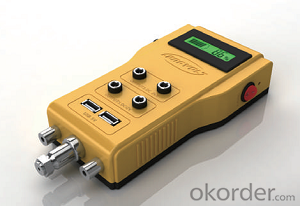
5. FAQ
- Package?
Carton, Transported by sea.
- Q: Can solar energy systems be used in areas with high altitude?
- Yes, solar energy systems can be used in areas with high altitude. In fact, solar panels can be even more effective in such areas due to the increased solar irradiance at higher altitudes. However, it is important to consider factors like temperature, snowfall, and extreme weather conditions that may affect the performance and maintenance of solar energy systems in high altitude areas.
- Q: How do solar energy systems impact the energy efficiency of a home?
- Solar energy systems can greatly impact the energy efficiency of a home by harnessing the power of the sun to generate electricity. By utilizing solar panels, a home can reduce its dependency on grid electricity, resulting in lower energy consumption and bills. Additionally, solar energy systems often generate more electricity than a home needs, allowing excess energy to be fed back into the grid, further reducing energy costs. Overall, solar energy systems promote a more sustainable and efficient use of energy in homes.
- Q: How does the tilt of solar panels affect their performance?
- The tilt of solar panels affects their performance by maximizing the amount of sunlight they receive. Adjusting the tilt angle allows panels to capture more sunlight at different times of the day and throughout the year, optimizing energy production.
- Q: Do solar energy systems require regular maintenance?
- Yes, solar energy systems do require regular maintenance. This includes cleaning the solar panels, checking for any damage or debris, and inspecting the overall system performance. Regular maintenance ensures optimal efficiency and longevity of the solar energy system.
- Q: How do solar energy systems affect the environment?
- Solar energy systems have a significantly positive impact on the environment. They are a renewable and clean source of energy, which means they do not produce harmful emissions or contribute to air pollution. This reduces the overall greenhouse gas emissions and helps combat climate change. Additionally, these systems do not require water for operation, unlike traditional fossil fuel power plants, reducing water scarcity issues in certain regions. Furthermore, solar energy systems have a minimal impact on land use. Rooftop solar panels can be installed on existing structures, maximizing the use of space and minimizing the need for additional land. Moreover, solar farms can be constructed on marginal or unused land, without disrupting natural habitats or valuable ecosystems. Solar energy systems also have a positive effect on human health. The reduction in air pollution and emissions from traditional energy sources leads to improved air quality, resulting in fewer respiratory and cardiovascular diseases. This, in turn, reduces healthcare costs and improves overall well-being. Another significant advantage of solar energy systems is their potential to create jobs and stimulate economic growth. The installation, maintenance, and manufacturing of solar panels require a skilled workforce, leading to the creation of new employment opportunities. Additionally, investing in solar energy infrastructure can help diversify the energy sector, reducing dependence on imported fuels and increasing energy security. While solar energy systems offer numerous environmental benefits, it is important to consider their potential challenges. The production and disposal of solar panels can have some environmental impact, primarily due to the use of certain materials during manufacturing. However, advancements in technology and recycling programs are continuously reducing these concerns. In conclusion, solar energy systems have a positive influence on the environment by reducing greenhouse gas emissions, minimizing air and water pollution, conserving land resources, improving human health, and stimulating economic growth. As we transition towards a more sustainable future, solar energy will play a crucial role in mitigating climate change and protecting the environment.
- Q: Can solar energy systems be used in powering recycling plants or waste management facilities?
- Certainly, recycling plants and waste management facilities can make great use of solar energy systems. These systems harness the sun's power to produce electricity, which can then be utilized to operate various equipment and machinery within these facilities. It is worth noting that these facilities require a significant amount of energy to power their operations, including machines for sorting and processing, conveyor belts, and other equipment. By installing solar panels on the roofs or in close proximity to these facilities, they can generate clean and renewable electricity, thus reducing their dependence on conventional energy sources. Solar energy systems offer numerous advantages for recycling plants and waste management facilities. Firstly, they provide a reliable and consistent source of energy, as the sun is readily available in most regions throughout the year. In contrast to fossil fuels or other non-renewable sources, solar energy systems do not deplete natural resources or contribute to greenhouse gas emissions, making them environmentally friendly. This aligns perfectly with the sustainability goals of recycling plants and waste management facilities, which aim to minimize the environmental impact of waste management processes. Moreover, solar energy systems can help these facilities save on energy costs. Once the initial investment in solar panels is made, the ongoing operational expenses are relatively low. Additionally, certain regions offer incentives and financial support for the installation of solar energy systems, further offsetting the initial investment and making it financially attractive. Furthermore, recycling plants and waste management facilities often possess ample surface areas suitable for solar panel installations, such as rooftops or open fields. This facilitates the installation of a sufficient number of solar panels to meet the energy demands of these facilities. In some cases, surplus energy generated by the solar panels can even be fed back into the electrical grid, enabling the facilities to generate revenue from the excess electricity. In conclusion, solar energy systems can effectively power recycling plants and waste management facilities. They present a sustainable and cost-effective solution, reducing dependence on traditional energy sources while aiding these facilities in achieving their environmental objectives.
- Q: Are there any limitations to the lifespan of solar energy systems?
- Yes, there are limitations to the lifespan of solar energy systems. The most significant limitation is the degradation of the solar panels over time. Solar panels are made up of photovoltaic (PV) cells that convert sunlight into electricity. These cells degrade gradually, losing efficiency as they age. On average, solar panels experience a degradation rate of around 0.5-1% per year, which means that after 25-30 years, the panels might only produce around 75-80% of their original power output. Another limitation is the lifespan of other components in the solar energy system, such as inverters, batteries (if present), and wiring. Inverters, which convert the DC electricity generated by the solar panels into AC electricity for use in homes or businesses, typically have a lifespan of 10-15 years. Batteries, if used for energy storage, also have a limited lifespan, usually around 5-10 years. Wiring can deteriorate over time due to exposure to the elements, requiring maintenance or replacement. Furthermore, environmental factors can impact the lifespan of solar energy systems. Extreme weather conditions like hailstorms, hurricanes, or heavy snow can damage solar panels, reducing their efficiency or even rendering them inoperable. Additionally, excessive heat can accelerate the degradation of solar panels, shortening their lifespan. However, it is important to note that while solar energy systems have limitations, proper maintenance and regular inspections can help maximize their lifespan and performance. Many solar panels come with warranties that guarantee their performance for a certain number of years, often ranging from 20 to 25 years. Moreover, technological advancements and improvements in manufacturing processes are constantly being made, which may lead to longer-lasting and more efficient solar energy systems in the future.
- Q: How do solar energy systems affect wildlife?
- Solar energy systems can have both positive and negative effects on wildlife. On one hand, solar panels do not produce air or water pollution, reducing the negative impacts on ecosystems. Additionally, solar farms can provide new habitats for certain species, particularly if the land was previously unused or disturbed. On the other hand, large-scale solar projects can disrupt natural habitats, displacing or disturbing wildlife populations. Moreover, solar panels can also pose threats to birds, as they may collide with the reflective surfaces. However, with proper planning and implementation, such negative impacts can be minimized, making solar energy systems a more sustainable choice for both humans and wildlife.
- Q: How much space do I need for a solar energy system?
- The space required for a solar energy system depends on various factors such as the size of the system, the amount of energy needed, and the efficiency of the solar panels. In general, for a residential solar energy system, you would need a roof space of about 100-400 square feet per kilowatt (kW) of solar panels. However, there are alternative options like ground-mounted systems or solar canopies that can be used if roof space is limited. It is recommended to consult with a solar energy professional who can assess your specific energy needs and available space to determine the appropriate size and configuration of the system.
- Q: Can a solar energy system be installed on a barn or agricultural building?
- Yes, a solar energy system can certainly be installed on a barn or agricultural building. In fact, it is becoming increasingly common for farmers and agricultural businesses to harness the power of solar energy to meet their electricity needs. Installing solar panels on barns or other agricultural buildings offers numerous benefits. Firstly, barns and agricultural buildings often have large rooftops or open areas, which provide ample space for installing solar panels. This allows for the efficient utilization of solar energy and can generate a significant amount of electricity. Secondly, installing a solar energy system on a barn or agricultural building can help reduce or even eliminate electricity costs for the property. This is particularly advantageous for farmers who typically have high energy consumption due to the operation of various equipment such as irrigation systems, lighting, ventilation, and machinery. Moreover, solar energy systems are environmentally friendly and produce clean, renewable energy. By installing solar panels, farmers can significantly reduce their carbon footprint and contribute to a greener and more sustainable future. Additionally, many governments and utility companies offer financial incentives, grants, or tax credits to encourage the adoption of solar energy systems. These incentives can help offset the initial installation costs and make the investment in solar energy more affordable for farmers. Lastly, a solar energy system on a barn or agricultural building can also serve as a backup power source during power outages, ensuring that critical operations can continue uninterrupted. In conclusion, installing a solar energy system on a barn or agricultural building is not only feasible but also highly beneficial. It allows farmers to reduce energy costs, lower their environmental impact, and potentially generate additional income through incentives or selling excess electricity back to the grid.
Send your message to us
Solid Solar Energy Split-Type Home Energy Storage System
- Loading Port:
- Shanghai
- Payment Terms:
- TT OR LC
- Min Order Qty:
- 1 set
- Supply Capability:
- 500 set/month
OKorder Service Pledge
OKorder Financial Service
Similar products
Hot products
Hot Searches
Related keywords
